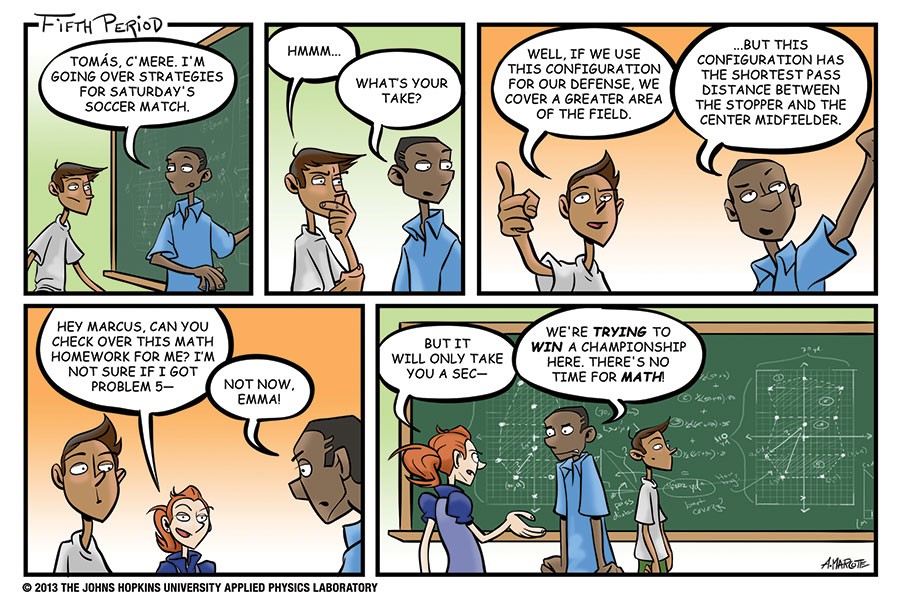Frame one: Meet Dwight Carr, a middle-aged African-American man with a shiny bald head and affable manner. He sits in his office in the Applied Physics Laboratory, wearing a short-sleeve white shirt and nondescript tie, staring upward, lost in thought. On his desk there's a small placard, STEM Outreach Manager, and a dusty black-and-white newspaper clipping with a photo of Sputnik and the headline, Race to Space. "It's been 50 years since teenagers really got excited about engineering and science," Carr muses. "We've got to find new ways to engage young people."
Frame two: Annie Marcotte, a young artist dressed all in black, with an asymmetrical short haircut and glasses perched halfway down her nose, sits sketching on a digital tablet in APL's communications offices. She's on deadline for her next installment of Fifth Period, a comic strip that follows four appropriately diverse teenagers—Sophie (for science), Tomás (technology), Emma (engineering), and Marcus (math)—along with their enthusiastic (yet close to retirement age) science teacher, Mr. Kepler. At Carr's request, Marcotte, in collaboration with technical writer Anne King and art director Don Vislay, has been creating the strip for three years, drawing on the interests and experiences of her co-workers and her father, brother, and sister, who are all engineers. She hopes she's making science and scientists seem more fun than nerdy, the subject matter more appealing than challenging. Today she's sketching an adventure for Sophie, her favorite character (the two share a love of dinosaurs, Jurassic Park, and learning new things), and she's working to get the voice of the dialogue and accompanying lesson just right—friendly and lively but not dumbed-down.
Frame three: Back in Carr's office, where he's studying analytics on his computer. We see that the Fifth Period pages on APL's STEM website average about 400 unique views a month. It's not quite the thousands that Carr would love to see. "I have grandiose ideas," he says with a half smile. ?("I have a tiny following among my friends," says Marcotte with a laugh.) On a shelf behind him, we see a stack of Fifth Period compilations, like graphic novels, that he has distributed to schools and career fairs by the thousands. An engineer by training, he likes to measure. But he doesn't have a good way of knowing how many readers are trying the experiments attached to each comic strip, or how many teachers may be working those experiments into their lessons. The teachers who come to APL STEM Outreach programs are all hungry? for real-life examples of science at work that they can bring back to their classrooms, he says. "The question that students are always asking is, 'How am I going to use this in the real world?'"
Frame four: Carr stands in APL's parking lot, watching colleagues head for their cars as the sun sets. He tells?a visitor that he has two focal points for outreach this year: helping teachers adjust to the problem-based learning style promoted by the national Common Core standards, and helping to fill corporate job needs in STEM fields. It's a numbers game, he says, thinking of all the baby boomers inspired by Sputnik who entered science and now are starting to retire. He sweeps one arm to take in a wide swath of the parking lot. "APL has some 5,000 employees, and more than two-thirds of them hold STEM-related degrees. We handle a lot of unique work for the Department of Defense. We can't continue to do those jobs if we can't keep filling the pipeline. So just from a self-preservation standpoint, we need to do something."
Frame five: The sun has set, but we see Annie Marcotte still in her office. Like Carr, she knows that if she can find ways to share the excitement and appeal of science and technology fields, she might just hook a few bright young minds. So she returns to her drawing board.
To read Fifth Period, click here.
Posted in Science+Technology
Tagged applied physics laboratory, stem education, stem, apl, comics








